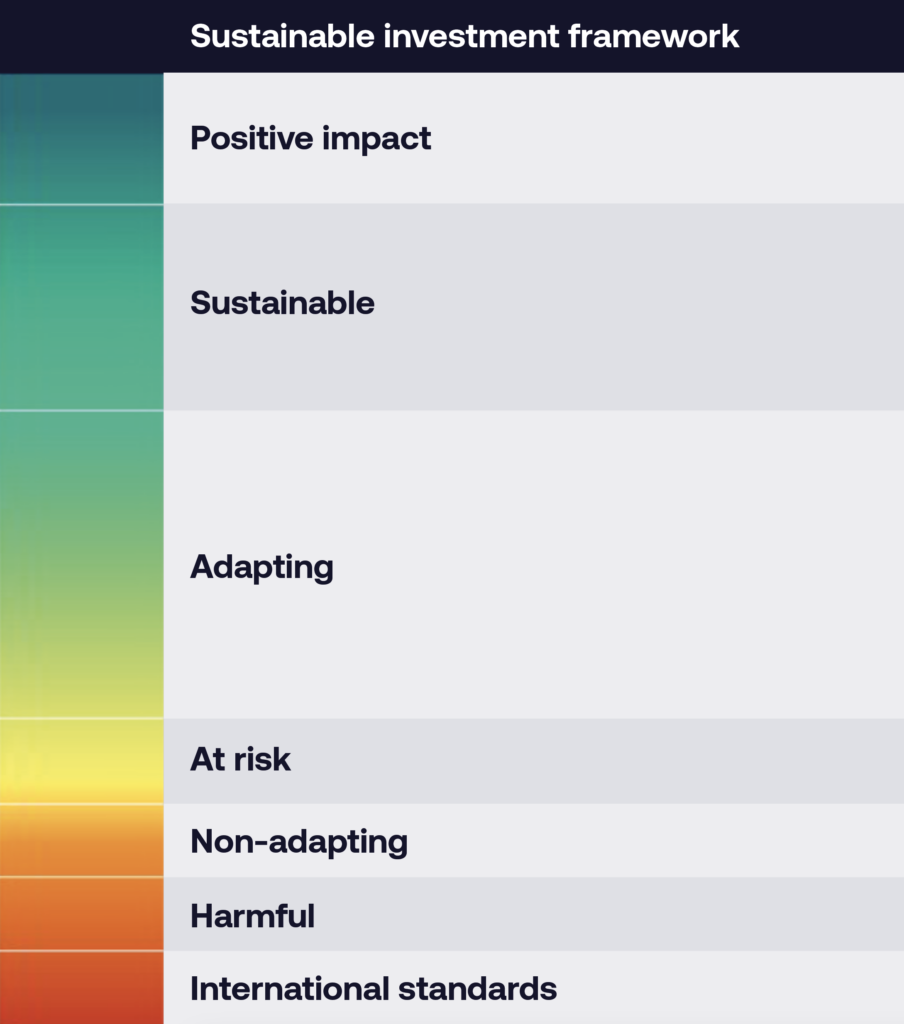Our approach to investing in the transition
We believe transition investing makes our investor portfolios more resilient to uncertainty and realises better returns, while achieving sustainable results in the real world. It’s also good risk management, requiring an understanding of complex systems such as the economy and nature.
We consider the impact of sustainability risks on our investments and the real-world impact of our investments and systemic risks to the economy – in other words, we follow a ‘double materiality’ approach to our investments.
Investing in the transition means being willing to invest in companies that, while producing essential goods and services, might have a negative impact today. It also means investing in companies that are already operating sustainably or that are having a positive impact and contributing to the transition.
We’re committed to investing in companies that are not yet fully sustainable – as long as we firmly believe in their future contribution to the transition. We want to support these companies to develop transition plans to help them address their negative impacts, such as contributing to climate change or biodiversity loss. However, it doesn’t mean any company is acceptable: they must show willingness to adapt and have the management capacity to execute on their plans.
Our Sustainable Investment Framework
Our Sustainable Investment Framework classifies companies that are transitioning towards sustainability. We consider:
- Does the behaviour and activities of the company fit within a sustainable society?
- Does the company violate international standards or is it involved in activities too harmful for society?
- How likely is the company to adapt or contribute to the transition to a sustainable society – through reducing negative impacts or accelerating positive contributions?
- Is it unlikely to adapt and therefore represents unacceptable risk to our portfolios or does it create too much negative real-world impact?
Based on these assessments we classify each investment using our Sustainable Investment Framework (see diagram on the left), which forms the foundation for all of our directly managed portfolios. We invest across a range of companies that create positive impact, are operating sustainably or are adapting to the transitions. As shown towards the bottom of the framework, we exclude companies if they don’t align with international standards, are involved in unacceptable harms or are clearly not adapting to the transition; and we avoid investing in companies that are at risk of failing to transition.
Our Sustainable Investment Framework
Our Sustainable Investment Framework classifies companies that are transitioning towards sustainability. We consider:
- Does the behaviour and activities of the company fit within a sustainable society?
- Does the company violate international standards or is it involved in activities too harmful for society?
- How likely is the company to adapt or contribute to the transition to a sustainable society – through reducing negative impacts or accelerating positive contributions?
- Is it unlikely to adapt and therefore represents unacceptable risk to our portfolios or does it create too much negative real-world impact?
Based on these assessments we classify each investment using our Sustainable Investment Framework (see diagram on the left), which forms the foundation for all of our directly managed portfolios. We invest across a range of companies that create positive impact, are operating sustainably or are adapting to the transitions. As shown towards the bottom of the framework, we exclude companies if they don’t align with international standards, are involved in unacceptable harms or are clearly not adapting to the transition; and we avoid investing in companies that are at risk of failing to transition.
Our approach to stewardship
Our responsibilities don’t stop when we have made an investment. We take our responsibilities as stewards of our client’s capital seriously (see our UK Stewardship Code Submission here). We engage with businesses in which we are invested (and vote and escalate issues where necessary) to improve their sustainable policies and practices. We are focused on stewardship of the systemic risks identified by our Sustainable Investment Framework.
Our approach to stewardship
Our responsibilities don’t stop when we have made an investment. We take our responsibilities as stewards of our client’s capital seriously (see our UK Stewardship Code Submission here). We engage with businesses in which we are invested (and vote and escalate issues where necessary) to improve their sustainable policies and practices. We are focused on stewardship of the systemic risks identified by our Sustainable Investment Framework.
It’s about delivering investment results for our clients
One example of companies that need to develop transition plans are those involved in the use and production of plastics. We believe companies with sound policies to reduce plastics may enjoy competitive advantages, including stronger brand performance and consumer trust, as customers are increasingly worried about the impact of plastic products in the environment. Given the increase of new regulations and the rising number of lawsuits, these companies will also be better prepared for upcoming regulations and legislative action.
See our case study here
We believe that investing in the transition will make our investor portfolios more resilient to uncertainty and realise better returns, while achieving sustainable results in the real world. It’s also good risk management, requiring an understanding of complex systems, such as the economy and nature.
It’s about delivering investment results for our clients
One example of companies that need to develop transition plans are those involved in the use and production of plastics. We believe companies with sound policies to reduce plastics may enjoy competitive advantages, including stronger brand performance and consumer trust, as customers are increasingly worried about the impact of plastic products in the environment. Given the increase of new regulations and the rising number of lawsuits, these companies will also be better prepared for upcoming regulations and legislative action.
See our case study here
We believe that investing in the transition will make our investor portfolios more resilient to uncertainty and realise better returns, while achieving sustainable results in the real world. It’s also good risk management, requiring an understanding of complex systems, such as the economy and nature.





